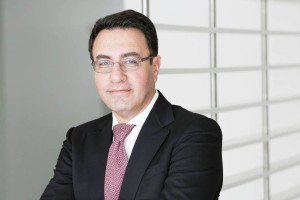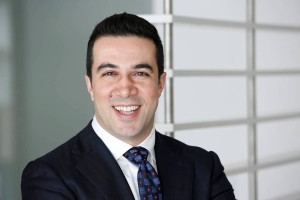General surgery is a surgical specialty that focuses on the abdominal area, including the esophagus, stomach, small bowel, colon, liver, pancreas, gallbladder and bile ducts, as well as on diseases involving the skin, breast, soft tissue and hernias.
According to the American Board of Surgery, general surgery is a discipline that demands knowledge of and familiarity with a broad spectrum of diseases that may require surgical treatment. While the breadth and depth of this knowledge will vary by disease category, the general surgeon is expected to be competent in diagnosing and treating the full spectrum of disease.
The K and B General Surgery team performs a wide range of minimally invasive procedures.
Laparoscopic Hernia Repair – A hernia occurs when the inside layers of the abdominal wall weaken and then bulge or tear. The inner lining of the abdomen pushes  through the weakened area to form a balloon-like sac. This, in turn, can cause a loop of intestine or abdominal tissue to slip into the sac, causing severe pain and other potentially serious health problems.
through the weakened area to form a balloon-like sac. This, in turn, can cause a loop of intestine or abdominal tissue to slip into the sac, causing severe pain and other potentially serious health problems.
Men and women of all ages can have hernias. Hernias usually occur either because of a natural weakness in the abdominal wall or from excessive strain on the abdominal wall such as strain from heavy lifting, substantial weight gain, persistent coughing, or difficulty with bowel movements or urination. Eighty percent of all hernias are located near the groin. Hernias might also be found below the groin (femoral), through the navel (umbilical), and along a previous incision (incisional).
Laparoscopic Cholecystectomy – The surgical removal of the gallbladder, a common and highly effective treatment for gallstones and other gallbladder conditions. General anesthesia is utilized, so the patient is asleep throughout the procedure.
An incision that is approximately half an inch is made around the umbilicus (belly button), and three other quarter-to-half inch incisions are made for a total of four incisions. Four narrow tubes called laparoscopic ports are placed through the tiny incisions for the laparoscopic camera and instruments. A laparoscope is inserted through the belly button port and connected to a special camera to provide the surgeon with a magnified view of the patient’s internal organs on a television screen. Long specially designed instruments are inserted through the other three ports that allow your surgeon to delicately separate the gallbladder from its attachments to the liver and the bile duct and then remove it through one of the ports from the abdomen. The surgeon may occasional perform an X-ray, called a cholangiogram, to examine for stones in the bile duct. After the gallbladder is removed from the abdomen, the small incisions are closed.
Laparoscopic Adrenalectomy – This minimally invasive surgery has become the preferred procedure for the management of most adrenal tumors. The operation is performed under a general aesthetic, and the patient is positioned lying on one side. Four 10-mm (3/8 in.) laparoscopic ports are placed just beneath the rib cage on the same side as the tumor. A fiberoptic camera is used to guide the operation, which typically lasts 1.5 to 2.5 hours. The post-operative pain is minimal, and recovery time is approximately two weeks.
Laparoscopic Splenectomy – The surgical removal of the spleen, an organ in the upper left part of the abdomen, beneath the ribs and behind the stomach. It filters blood to remove bacteria, parasites, and other organisms that can cause infection. It also removes old and damaged blood cells.
There are several reasons why a spleen might need to be removed. These include trauma to the spleen, spleen rupture due to tumor, infection, inflammatory condition, or medicines; enlargement of the spleen (splenomegaly); certain blood disorders; cancers such as leukemia or lymphoma; a diseased spleen, due to disorders like HIV infection; liver disease; and a tumor or abscess in the spleen.
Laparoscopic Gastric Resection – The surgical removal of all or part of the stomach, usually performed to treat stomach cancer or an intractable peptic ulcer.
 Port-a-Cath Placement/Removal – A port-a-cath is a small device, placed under the skin, the empties into a blood vessel and makes it easier to provide the patient with chemotherapy and to take blood for tests.
Port-a-Cath Placement/Removal – A port-a-cath is a small device, placed under the skin, the empties into a blood vessel and makes it easier to provide the patient with chemotherapy and to take blood for tests.
Biopsy – A simple surgical procedure done to remove cells or tissues from an area of concern in the body. The sample is then sent to a pathologist for diagnostic analysis. There are three types of biopsy: the removal of only a sample of tissue (incisional biopsy or core biopsy); the removal of a sample of tissue or fluid with a needle (needle biopsy or fine-needle aspiration); or the removal of an entire tumor or lesion (excisional biopsy).
Colectomy – A surgical procedure to remove all or part of the colon (large intestine). It may be necessary to treat or prevent diseases and conditions that adversely affect the health of the colon. There are various types of colectomy operations: a total colectomy (in which the entire colon is removed); a partial or subtotal colectomy (in which part of the colon is removed); a hemicolectomy (in which the right or left portion of the colon is removed); and a proctocolectdomy (in which both the colon and rectum are removed). There are several conditions that may require a colectomy for treatment:
• Uncontrollable bleeding – Severe bleeding from the colon
• Bowel obstruction
• Colon cancer
• Crohn’s disease
• Ulcerative colitis
• Diverticulitis
• Preventative surgery (if the patient has a very high risk of developing colon cancer
due to the formation of multiple precancerous colon polyps)
Laparoscopic colectomy involves several small incisions in the abdomen. The surgeon passes a tiny video camera (laparoscope) through one incision and special surgical tools through the other incisions — and then watches a video screen the tools are used to free the colon from the surrounding tissue. The colon is then brought out through a small incision in the abdomen. This allows the surgeon to operate on the colon outside of the patient’s body. Once repairs are made to the colon, the surgeon reinserts the colon through the incision.
Small Bowel Resection – Surgery to remove a portion or all of the small intestine. In the laparoscopic procedure, the surgeon makes three to five small incisions in the lower belly and passes a camera (laparoscope) and medical instruments through these cuts. The belly is filled with gas to expand it to make it easier for the surgeon to see and work. If there is enough healthy small intestine left, the surgeon will sew or staple the healthy ends of the small intestine back together. Most patients have this done. If the patient does not have enough healthy small intestine to reconnect, the surgeon will make an opening called a stoma through the skin of the belly and attach what’s left of the small intestine to the outer wall of the belly. This will allow stool to go through the stoma and into a drainage bag or pouch outside the body (a procedure known as an ileostomy). The ileostomy may be either short-term or permanent.
Ulcer Repair – An ulcer occurs when part of the lining of the stomach or intestine becomes deeply eroded. This typically happens in the stomach (gastric ulcer) or in the duodenum (duodenal ulcer), which is located at the lower end of the stomach and the beginning of the small intestine. Ulcers range from quite small to an inch or more in size. Surgical treatment may be necessary if complications do not respond to other therapy (including diet modification and medicine). Laparoscopic repair of perforated ulcers is a safe effective and minimally evasive approach in which the surgeon applies electricity, heat, or small clips to coagulate the blood and stop the bleeding. This procedure also causes fluid buildup, which helps to compress the blood vessels. In high-risk cases, the doctor may inject epinephrine (commonly known as adrenaline) directly into the ulcer to enhance the effects of the heating process. Epinephrine activates the process leading to blood coagulation, narrows the arteries, and enhances blood clotting.
Hemorrhoids – Hemorrhoids are vascular structures in the anal canal that help with stool control. When they become swollen or inflamed, they can be uncomfortable and lead to rectal bleeding and other symptoms. In severe cases, when a patient does not respond to standard treatment (including increasing fiber intake, oral fluids to maintain hydration, anti-inflammatories to help relieve the pain and rest), surgery may be an option.
Surgery to remove hemorrhoids is called hemorrhoidectomy. Incisions are made in the tissue around the hemorrhoid. The swollen vein inside the hemorrhoid is tied off to prevent bleeding, and the hemorrhoid is removed.
Meet our General Surgery Team
Theodore M. Khalili, M.D., F.A.C.S.
A well-known and highly regarded surgeon, Dr. Khalili is the Founder and Director of the Khalili Center for Bariatric Care. Over the last ten years, he has performed more  than 4,000 bariatric and advanced laparoscopic surgeries—including the nation’s first robotic-assisted gastric bypass in 2002.
than 4,000 bariatric and advanced laparoscopic surgeries—including the nation’s first robotic-assisted gastric bypass in 2002.
A pioneer in the field of minimally invasive bariatric surgery in Los Angeles, Dr. Khalili helped start the Weight Loss Surgery Program at Cedars-Sinai Medical Center, and until June 2010 served as its Director. He has trained many surgeons in minimally invasive weight loss surgery, who have gone on to head up bariatric care programs all over the country. An accomplished teacher, Dr. Khalili won the Golden Apple Award as an outstanding educator in 2005 from Cedars-Sinai. He is also an Assistant Clinical Professor in Surgery at the David Geffen School of Medicine, University of California, Los Angeles.
Board certified in both General Surgery and Surgical Critical Care, Dr. Khalili is a member of the American College of Surgeons, American Society of Bariatric Surgery, American Medical Association and the Society of American Gastrointestinal Endoscopic Surgeons (SAGES). He is the author of numerous papers and presentations on a variety of subjects, including laparoscopic surgery, bariatric surgery, organ transplantation and bio-artificial liver treatment. He has published and spoken nationally and internationally and his work underscores his commitment to the ongoing advancement of new surgical procedures and technologies.
Dr. Khalili holds a Bachelor’s of Science in Cell Biology from California State University, Northridge and earned his medical degree from The Chicago Medical School. While in medical school, he was elected to the Alpha Omega Alpha medical honor society. He completed his internship and residency in General Surgery at Cedars-Sinai Medical Center, where he also served a fellowship in Surgical Critical Care. Dr. Khalili’s work was recognized with a Research Prize in 1997 from the Pacific Coast Surgical Association. Married to the love of his life, Dr. Khalili has two teenage daughters and enjoys tennis and basketball.
Gregg Kai Nishi, M.D., F.A.C.S.
Dr. Nishi brings a wealth of expertise and experience to the Khalili Center. He’s an expert in innovative, minimally invasive surgical techniques and has spoken extensively on the subject, having appeared in a variety of news media, including Good Morning America and the Los Angeles Times. He has trained a number of other bariatric surgeons who have gone on to head up bariatric programs all over the country in their own right.
on the subject, having appeared in a variety of news media, including Good Morning America and the Los Angeles Times. He has trained a number of other bariatric surgeons who have gone on to head up bariatric programs all over the country in their own right.
Formerly the Assistant Director of the Cedars-Sinai Center for Minimally Invasive and Weight Loss Surgery, Dr. Nishi was also an attending surgeon in Trauma Services and Surgical Intensive Care at Cedars-Sinai. He is one of the principal investigators of the FDA trials on a new procedure called TOGA (incision-less weight loss surgery), and is one of only a handful of surgeons in the U.S. who have performed this procedure.
Currently Assistant Clinical Professor of Surgery at the David Geffen School of Medicine, UCLA, Dr. Nishi has published widely in such journals as American Surgeon and Bariatric Times, and lectures on weight loss surgery at national and international bariatric surgery conferences. He is the recipient of numerous awards, including the Paul Rubenstein, MD Prize for Excellence in Resident Research Abstract and Awards Presentation; the Society of Laparoendoscopic Surgeons Resident Achievement Award; and the Leo G. Rigler, MD Award for Academic Achievement from Cedars-Sinai. An Associate Fellow of the American College of Surgeons, Dr. Nishi is also a member of SAGES, the Society of American Gastrointestinal Endoscopic Surgeons; American Medical Association; and Society of Laparoendoscopic Surgeons.
After earning his Bachelor of Science degree in Biology from the University of California, Irvine and a medical degree from George Washington University School of Medicine, Dr. Nishi went on to intern in the Department of Surgery at North Shore University Hospital in Manhasset, New York, where he was named resident of the year. He received his surgical training at Cedars-Sinai Medical Center including a Fellowship in Surgical Critical Care. A Southern California native, Dr. Nishi lives in Los Angeles with his lovely wife and young daughter. Dr. Nishi enjoys skiing, biking, and car racing.
Eraj Basseri, M.D.
Dr. Eraj Basseri, a general and bariatric surgeon, is one of the partners at the Khalili Center. Dr. Basseri was intimately involved in developing the Khalili Center, working with his colleagues Doctors Theodore M. Khalili and Gregg Kai Nishi to bring to life a unique, comprehensive and holistic approach to bariatric and general surgery care. Dr. Basseri is fiercely committed to providing patients the best and most individualized medical care possible. His friendly, easygoing approach and personal warmth put patients at ease the moment they meet him. His educational approach allows patients to better understand and become actively involved in their own medical care.
Dr. Basseri is knowledgeable of the latest and most innovative surgical techniques and equipment available. Instrumental in training and bringing da Vinci robotic surgery availability to the Center, he is dedicated to having the best and latest technology for Khalili Center patients.
Dr. Basseri received a Bachelor of Science in Neuroscience from University of California, Los Angeles; and received his Doctor of Medicine from the University of California, San Diego. He completed a coveted fellowship in the Minimally Invasive and Weight Loss Surgery Department at Cedars Sinai. His innate surgical skills were continually singled out during his tenure there and he received the Society of Laparoendoscopic Surgeons Resident Achievement award as well as an appointment as Administrative Chief Resident. Dr. Basseri is a member of the Society of American Gastrointestinal & Endoscopic Surgeons (SAGES) and the Society of Laparoendoscopic Surgeons (SLS). He has published numerous research papers and presented on a number of topics both nationally and internationally.
A native of Los Angeles, Dr. Basseri enjoys playing basketball, weightlifting, and spending time with his family and friends.
